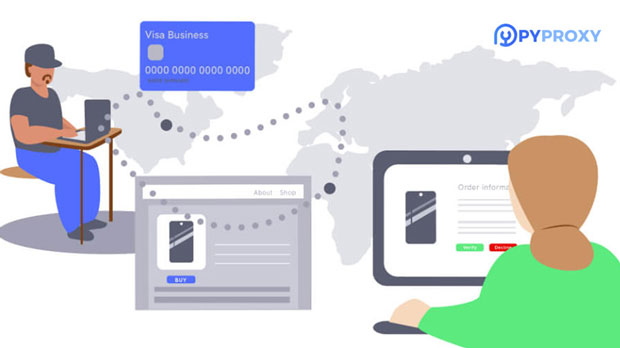In today's digital landscape, proxies play a crucial role in maintaining anonymity, bypassing geographical restrictions, and enhancing the security of online activities. With businesses and individuals increasingly relying on proxies for tasks such as web scraping, data mining, and managing multiple social media accounts, selecting the right type of proxy becomes vital. Among the various options available, Proxy Premium is emerging as a popular choice for long-term projects. But how reliable is Proxy Premium in such settings? This article delves into the key features, advantages, and challenges of using Proxy Premium for long-term projects, providing a comprehensive understanding of its effectiveness in this context. What Is Proxy Premium?Proxy Premium refers to high-quality, private proxies that are typically offered by premium proxy service providers. Unlike free proxies or shared proxies, which are often slow and unreliable, Proxy Premium services offer fast speeds, high levels of security, and greater reliability. These proxies are generally assigned to individual users or specific businesses, providing dedicated bandwidth and IPs, which results in fewer restrictions and improved performance.These proxies are often used in more critical tasks such as SEO analysis, social media management, competitive intelligence, and web scraping, where consistent performance is required over an extended period. The premium nature of these proxies means that they come at a cost, but the benefits often outweigh the price, particularly for long-term projects where downtime or lag can lead to significant losses.Key Benefits of Proxy Premium for Long-Term ProjectsWhen selecting a proxy for long-term use, several factors come into play, such as reliability, speed, and security. Proxy Premium provides notable advantages for businesses and individuals looking to carry out continuous, uninterrupted tasks over extended periods.1. Consistent PerformanceOne of the primary benefits of Proxy Premium is its ability to provide consistent performance. Premium proxies are designed to maintain high-speed connections without throttling or downtime, which is crucial for long-term projects. Whether you're scraping large amounts of data or running automated tools for SEO purposes, a reliable proxy ensures that your activities continue smoothly without interruptions, thereby saving time and effort.2. Enhanced Security and PrivacySecurity is a major concern when it comes to online activities. Proxy Premium services offer robust security features such as encryption, anonymous browsing, and IP masking. These features prevent hackers, advertisers, and other third parties from tracking your online activities. For long-term projects, such as managing multiple social media accounts or handling sensitive client data, this enhanced security is essential to prevent unauthorized access and protect sensitive information.3. Bypassing Geographical RestrictionsAnother significant advantage of Proxy Premium is its ability to bypass geographical restrictions. In some long-term projects, accessing content from specific regions or countries is crucial. For example, businesses may need to track competitors in different regions or gather data from websites that are geo-restricted. Proxy Premium allows users to choose IP addresses from specific locations, enabling seamless access to blocked content without compromising on speed or quality.4. Reliable Customer SupportLong-term projects require more than just reliable proxies; they also require strong customer support. Proxy Premium services often come with 24/7 customer support, ensuring that users have access to assistance whenever needed. Whether you're facing technical issues or need guidance on proxy configurations, having prompt support can prevent delays and ensure the smooth progression of long-term projects.5. ScalabilityScalability is an essential feature for long-term projects that require expanding operations or increasing the amount of data being processed. Proxy Premium services typically allow users to scale their operations by offering large pools of IP addresses and varying bandwidth options. This scalability makes it easier to handle increased demands as projects grow, without compromising on performance or quality.Challenges of Using Proxy Premium for Long-Term ProjectsWhile Proxy Premium offers numerous advantages, it is not without its challenges. Understanding these potential issues can help businesses and individuals make an informed decision about whether Proxy Premium is suitable for their long-term needs.1. Cost ConsiderationsOne of the main challenges of using Proxy Premium is its cost. These proxies tend to be significantly more expensive than shared or free proxies. For long-term projects with tight budgets, this can be a deterrent. However, it is important to weigh the cost against the potential benefits, such as reliability, performance, and security, which may ultimately save money in the long run by preventing delays and inefficiencies.2. Possible IP BlocksWhile Proxy Premium services typically offer dedicated IPs, there is still a risk of IP blocks, particularly when performing activities such as web scraping or bulk account management. Some websites and platforms may detect and block proxy ips if they are used too frequently or suspiciously. To mitigate this risk, users may need to rotate IPs or employ additional proxy strategies, such as using residential or rotating proxies.3. Limited Availability of High-Quality ProxiesNot all Proxy Premium providers offer the same level of service. Some may provide unreliable proxies that experience downtime or poor performance during peak hours. It is essential to carefully research and choose a reputable Proxy Premium service to ensure that your long-term project is not hindered by poor proxy quality.Best Practices for Using Proxy Premium in Long-Term ProjectsTo maximize the reliability and effectiveness of Proxy Premium in long-term projects, consider implementing the following best practices:1. Regularly Monitor Proxy PerformanceTo ensure that your proxies are performing as expected, regularly monitor their speed, uptime, and overall performance. Many Proxy Premium services offer tools to track these metrics, allowing you to identify and resolve any issues early on.2. Rotate IPs When NecessaryIf you're using Proxy Premium for activities such as web scraping or automation, rotating your IP addresses can help prevent blocks and maintain anonymity. Some services offer automatic IP rotation features, which can simplify this process.3. Choose a Reliable Proxy ProviderThe key to a successful long-term project with Proxy Premium lies in selecting a reliable provider. Look for providers with positive reviews, a strong track record, and responsive customer support. Ensure that they offer the features and support that are essential for your specific needs.In conclusion, Proxy Premium is an excellent choice for long-term projects that require reliable, secure, and fast proxies. With consistent performance, enhanced security, and the ability to bypass geographical restrictions, Proxy Premium helps businesses and individuals achieve their objectives without interruptions. However, it is important to consider the associated costs and potential challenges, such as IP blocks and the need for high-quality proxies. By choosing a reliable provider and implementing best practices, users can maximize the effectiveness of Proxy Premium for their long-term projects.
Oct 11, 2025



































































